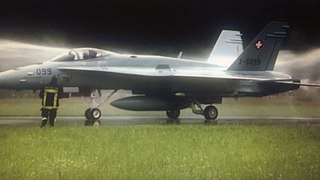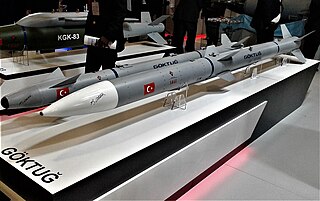The AIM-120 Advanced Medium-Range Air-to-Air Missile, or AMRAAM, is an American beyond-visual-range air-to-air missile capable of all-weather day-and-night operations. It is 7 in (18 cm) in diameter, and employs active transmit-receive radar guidance instead of semi-active receive-only radar guidance. It is a fire-and-forget weapon, unlike the previous generation Sparrow missiles which needed guidance from the firing aircraft. When an AMRAAM missile is launched, NATO pilots use the brevity code Fox Three.
The AIM-54 Phoenix is an American radar-guided, long-range air-to-air missile (AAM), carried in clusters of up to six missiles on the Grumman F-14 Tomcat, its only operational launch platform.

The McDonnell Douglas F-15 Eagle is an American twin-engine, all-weather tactical fighter aircraft designed by McDonnell Douglas. Following reviews of proposals, the United States Air Force (USAF) selected McDonnell Douglas's design in 1969 to meet the service's need for a dedicated air superiority fighter. The Eagle first flew in July 1972, and entered service in 1976. It is among the most successful modern fighters, with over 100 victories and no losses in aerial combat, with the majority of the kills by the Israeli Air Force.

The McDonnell Douglas F/A-18 Hornet is an all-weather, twin-engine, carrier-capable, multirole combat aircraft, designed as both a fighter and attack aircraft. Designed by McDonnell Douglas and Northrop, the F/A-18 was derived from the latter's YF-17 in the 1970s for use by the United States Navy and Marine Corps. The Hornet is also used by the air forces of several other nations, and formerly by the U.S. Navy's Flight Demonstration Squadron, the Blue Angels.
Raytheon Missiles & Defense (RMD) is one of four business segments of Raytheon Technologies. Headquartered in Tucson, Arizona, its president is Wes Kremer. The business produces a broad portfolio of advanced technologies, including air and missile defense systems, precision weapons, radars, and command and control systems.

The Advanced Short Range Air-to-Air Missile (ASRAAM), also known by its United States designation AIM-132, is an imaging infrared homing air-to-air missile, produced by MBDA UK, that is designed for close-range combat. It is in service in the Royal Air Force (RAF), replacing the AIM-9 Sidewinder. ASRAAM is designed to allow the pilot to fire and then turn away before the opposing aircraft can close for a shot. It flies at well over Mach 3 to ranges in excess of 25 kilometres (16 mi). It retains a 50 g manoeuvrability provided by body lift technology coupled with tail control.

The IRIS-T is a medium range infrared homing missile available in both air-to-air and ground defence surface-to-air variants.

The McDonnell Douglas CF-18 Hornet is a Royal Canadian Air Force (RCAF) variant of the American McDonnell Douglas F/A-18 Hornet fighter aircraft. In 1980, the F/A-18 was selected as the winner of the New Fighter Aircraft Project competition and awarded a production order; deliveries of the CF-18 to the Canadian Armed Forces began in 1982. CF-18s have supported North American Aerospace Defense Command (NORAD) air sovereignty patrols and participated in combat during the Gulf War in 1991, the Kosovo War in the late 1990s, and as part of the Canadian contribution to the international Libyan no-fly zone in 2011. CF-18s were also part of the Canadian contribution to the military intervention against ISIL, Operation Impact.

The Boeing F/A-18E and F/A-18F Super Hornet are twin-engine, carrier-capable, multirole fighter aircraft variants based on the McDonnell Douglas F/A-18 Hornet. The F/A-18E single-seat and F/A-18F tandem-seat variants are larger and more advanced derivatives of the F/A-18C and D Hornet.
A beyond-visual-range missile (BVR) is an air-to-air missile (BVRAAM) that is capable of engaging at ranges of 20 nmi (37 km) or beyond. This range has been achieved using dual pulse rocket motors or booster rocket motor and ramjet sustainer motor.

NASAMS is a distributed and networked short- to medium-range ground-based air defense system developed by Kongsberg Defence & Aerospace (KDA) and Raytheon. The system defends against unmanned aerial vehicles (UAVs), helicopters, cruise missiles, unmanned combat aerial vehicles (UCAVs), and fixed wing aircraft, firing any of a wide range of existing missiles.

A hardpoint is an attachment location on a structural frame designed to transfer force and carry an external or internal load. The term is usually used to refer to the mounting points on the airframe of military aircraft that carry weapons, ordnances and support equipments, and also include hardpoints on the wings or fuselage of a military transport aircraft, commercial airliner or private jet where external turbofan jet engines are often mounted.

The AN/APG-79 is a variant of an active electronically scanned array (AESA) radar developed for the United States Navy's Boeing F/A-18E/F Super Hornet and Boeing EA-18G Growler aircraft, providing a high level of aircrew situational awareness. The beam of the AESA radar provides fast track updates and multi-target tracking capability. The APG-79 AESA uses transmit/receive (TR) modules populated with gallium arsenide monolithic microwave integrated circuits (MMIC). In the F/A-18E/F, the radar is installed in a slide-out nose rack to facilitate maintenance.
VFAX for Naval Fighter Attack Experimental was actually two specifications for two US Navy fighter projects. The first was for a low cost lightweight complement for the General Dynamics–Grumman F-111B which could replace the McDonnell F-4 Phantom II for air superiority, escort, and ground attack missions in the early 1960s. This role was dropped in favor of the VFX aircraft, which emerged as the F-14 Tomcat. The second VFAX evolved when the VFX proved too costly to replace all existing USN fighters and attack aircraft, and the Navy was invited to take part in the USAFs Lightweight Fighter Program (LWF). The Navy chose the YF-17, the loser of the LWF contest as its Navy Air Combat Fighter, as it was inherently more suitable to naval operations than the winning General Dynamics F-16 Fighting Falcon; it was redesigned to become the McDonnell Douglas F/A-18 Hornet.
VX-4, Air Test and Evaluation Squadron Four,, commonly referred to by its nickname of The Evaluators, was a United States Navy air test and evaluation squadron based at Naval Air Station Point Mugu, California. Their tail code was XF, and they flew the McDonnell Douglas F-4 Phantom, Grumman F-14 Tomcat and the McDonnell Douglas F/A-18 Hornet until their disestablishment in 1994.

The AIM-9 Sidewinder is a short-range air-to-air missile which entered service with the United States Navy in 1956, and subsequently was adopted by the US Air Force in 1964. Since then, the Sidewinder has proved to be an enduring international success, and its latest variants remain standard equipment in most Western-aligned air forces. The Soviet K-13, a reverse-engineered copy of the AIM-9B, was also widely adopted by a number of nations.

The GBU-53/B StormBreaker, previously known as the Small Diameter Bomb II, is an American air-launched, precision-guided glide bomb.

The Hugo Wolf F/A-18C simulator is a realistic non-flying replica of a McDonnell Douglas F/A-18 Hornet, used as an interactive training simulator for operational ground staff. It is fitted with specialised equipment to simulate various emergency scenarios. Two examples are used by the Swiss Air Force.

GÖKTUĞ is a Turkish program by TÜBİTAK-SAGE to develop four variants of air-to-air missiles that are to be launched from F-16s as well as future Turkish indigenous Hürjets and TF-Xs. These missiles are going to be Turkey's first indigenous air-to-air missiles. Bozdoğan (Merlin) are short-range infrared homing and Gökdoğan (Peregrine) are beyond visual range active radar homing missiles. Both missiles were successfully flight-tested in 2018. The missiles are also planned to be integrated on Bayraktar AKINCI and Bayraktar Kızılelma, indigenously developed Turkish UCAVs.













